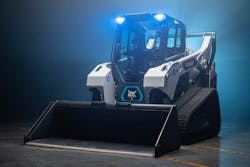Bobcat Electric CTLs Cut Operating Costs
Joel Honeyman, VP of global innovation, has been leading the charge in reinventing Bobcat’s CTL. The company has been field testing the T7X, giving contractors and operators a hands-on opportunity to try out the new electric compact track loader. The loaders will be available to rent later this year through Sunbelt Rentals, and for sale in 2023 at dealers.
“Without exception, every operator gets out of the cab smiling,” says Honeyman. “Many tell me that if all of the vehicles they had to operate were as quiet and smooth as our T7X, they would be able to extend their career 10 to 15 years.”
In tight labor markets, a seasoned operator has immeasurable value: no new hire costs, no training costs, and no newbie mistakes to correct.
“We started with a Bobcat T550 CTL, a smaller diesel machine, to see if the battery-powered loader would work,” Honeyman says. “Did we want to just take a regular machine and put a battery in it? That sounded very underwhelming. Instead, we looked at what the electric car companies have done and took the opportunity to change the platform.”
Electric CTL eliminates leaks
The first task was eliminating CTL components that leaked.
“We just wanted to get rid of hydraulics everywhere,” Honeyman says. CTLs frequently work in enclosed or indoor environments, and leaving diesel fuel or oil puddles is a problem. Burnt fuel emissions in a contained area are unacceptable. A cracked hydraulic hose leaking fluid becomes a toxic incident. All end up costing money to clean up and fix.
Bobcat replaced its diesel engine with a 62kW lithium-ion battery and the hydraulic components with electric actuator motors. Gone are the 57 gallons of fluid required to run the standard compact track loader. The T7X carries a miniscule quart of eco-friendly coolant. The T7X will recharge off a 30-amp 220 service, but it can also recharge on a 110v power source using a standard off-the-shelf EV adaptor. Bobcat warranties the battery for five years and electrical components for three years.
The T7X “smart” telematics let the operator change machine preferences, tuning the CTL’s performance to specific job situations. This means the machine’s intuitive power management system intelligently distributes energy to meet the task, wasting nothing. Unlike a diesel engine, 100 percent full power is available instantly—no waiting for a hydraulic system to build up power. Operator time is used more efficiently.
Then there is the non-cost of zero diesel fuel to purchase and store. Bobcat says the T7X costs about 1/10th to run compared to a standard CTL. It says a diesel-powered CTL used for approximately 500 hours a year costs about $7,000 for fuel, fluids, and maintenance. The electricity to charge the T7X for the same 500 hours is about $700.
As for line-item operating cost savings, Honeyman suggests listing what you don’t need to budget for. First, there are 50 percent fewer parts on the Bobcat EV CTL, so there is less to maintain. Consumables do not need to be updated or reordered. The only daily maintenance needed is to make sure the lifter is greased and to download an occasional software update. With so little to maintain and replace, technician costs are also lower.
